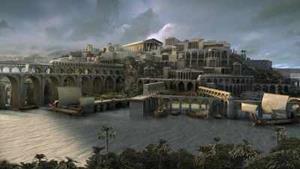Is lost Atlantis in Doñana?
The interest in this mythical city has reached as far as Russia
Ever since the philosopher Plato mentioned in his Dialogues the possibility of the mythical city could be situated opposite the Pillars of Hercules (the Strait of Gibraltar), the have been more than a few studying the theme and have concluded that the real location is known today as the Doñana National Park.

A recreation of the mythical city of Atlantis - www.ABC.es
The interest in deciphering this enigma has reached as far as Russia, where magazines have reported on the initiative ‘Doñana-Atlantis-Project’ driven by the Anglo Hispanic association ‘The Happy Little Donkey’, the headquarters of which are in Hinojos (Huelva), and is dedicated to visit the zone with donkeys to avoid damaging the environment.
It was Alfred Schulten (1870-1960) the German historian and philologist, who was one of the first experts who tried to demonstrate the Atlantis, was in reality the capital of the Tartessos reign, this is a semi-mythical harbour city and the surrounding culture on the south coast of the Iberian Peninsula, at the mouth of the Guadalquivir River.
During several campaigns carried out at the start of the last century, Schulten searched effortlessly in Doñana for remains of Tartessos, but he never found anything. Fundamentally, he concentrated his time in a region of the park known as Cerro del Trigo.
The Cerro del Trigo offered other revelations, of a distinct epoch. In the excavations realised in the zone in 1923, Schulten counted on the help of the archaeologist Jorge Bonsor. He left behind a written account explaining the result of their labours: a Roman population with a salting factory dating from the III century after Christ.
Much later, in 2011, an international group of investigators with the backing of the United States National Geographic Society said they had found indications of Atlantis under the marshes of the Doñana Park. The team of geologists and archaeologists was directed by the professor Richard Freund, who invested two years of work with the help of satellite photographs and ground penetrating radar, digital cartography and submarine technology. The professors from the University of Huelva Juan Antonio Morales and Claudio Lozano formed a part of this multidiscipline team.
Another historian from Cádiz Manuel Cuevas also assured last September, from aerial photography, he had located Atlantis inside the protected nature space.
Lastly, using all these ingredients, the environmental Anglo Hispanic association ‘The Happy Little Donkey’ decided to start regular visits to the area in their initiative ‘Doñana-Atlantis-Project’
According to the Briton, Wendy Clements, vice-president of the association, who remains curious how Russia has shown great interest despite nobody there realises where Doñana is and what it represents. ‘We thank for their collaborative benefit for the Park and the foreign prestige which has been aroused by our initiative’.
Clements added she was working hard to have their website to be translated into Russian, to further increase the attention of those interested in this enormous country.
According to the promoters, a dozen of Russian tourism magazines have donated space to their project. Their webpage www.asociacionelburritofeliz.org’ is receiving visits from around the world, some 300,000. Atlantis is always of interest, and more so for the possible link to Doñana.
